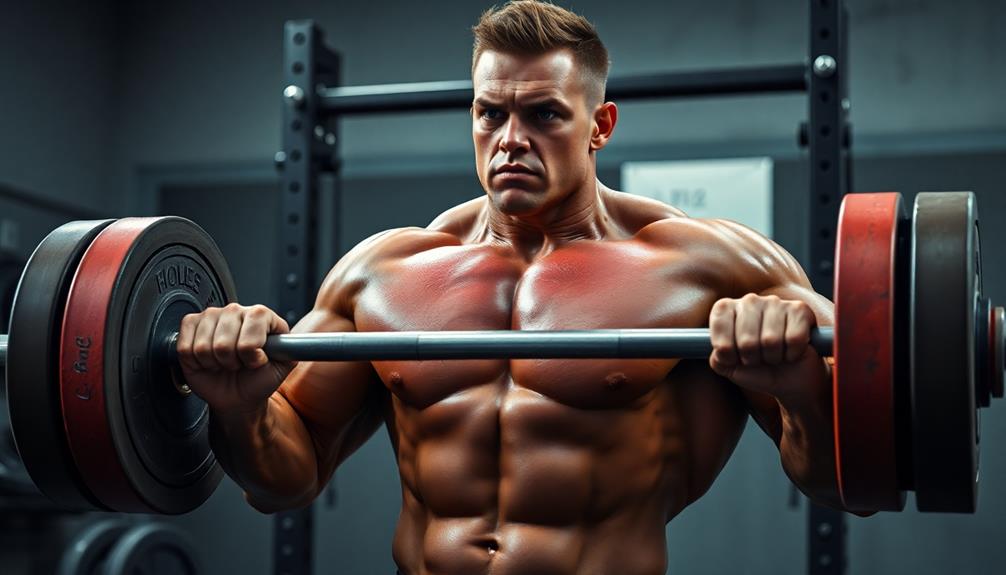Powerlifting builds muscle effectively through several key mechanisms. You'll engage in heavy compound movements like squats, bench presses, and deadlifts, which activate multiple muscle groups simultaneously. Progressive overload, where you gradually increase weight and intensity, stimulates continuous muscle growth. The high-intensity nature of powerlifting triggers a significant hormonal response, boosting testosterone and growth hormone production. This style of training primarily targets fast-twitch muscle fibers, leading to increased muscle size and strength. By focusing on proper form, maintaining a consistent routine, and supporting your efforts with adequate nutrition, you'll maximize your muscle-building potential. Discover how these elements work together to transform your physique.
Core Insight
- Powerlifting's compound movements engage multiple muscle groups, maximizing muscle growth and strength gains.
- Heavy lifting stimulates hormone production, including testosterone and growth hormone, which aid muscle development.
- Progressive overload in powerlifting constantly challenges muscles, promoting continuous growth and adaptation.
- Powerlifting targets fast-twitch muscle fibers, leading to increased muscle size and power.
- Consistent powerlifting routines with proper form and recovery promote effective muscle hypertrophy over time.
The Science Behind Powerlifting Muscle Growth
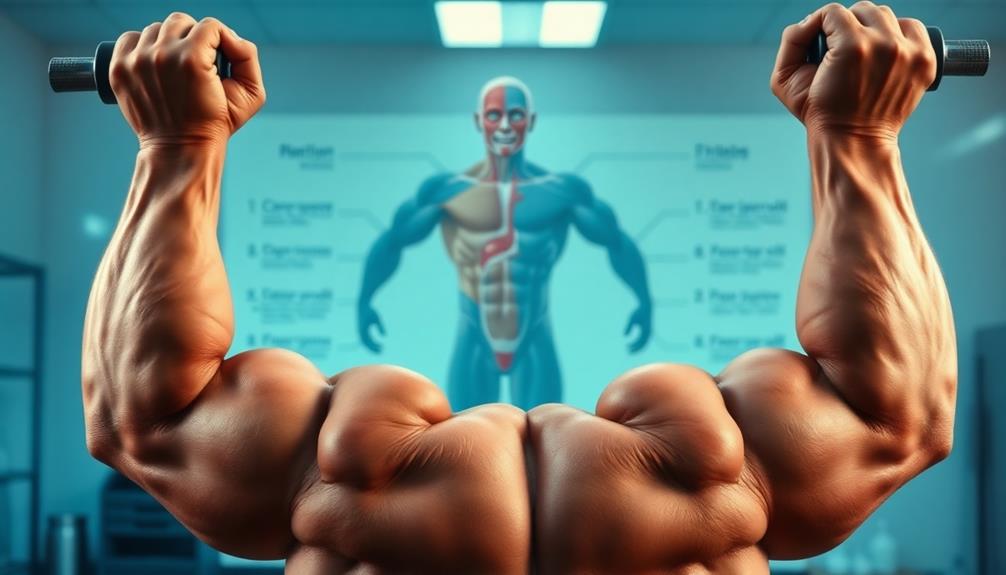
Powerlifting is a great way to build muscle naturally. Lifting heavy weights creates tiny tears in your muscles. When your body repairs these tears, your muscles get bigger and stronger. This process is called muscle hypertrophy.
Powerlifting also makes your body produce more testosterone and growth hormone. These hormones are important for growing muscle. Powerlifting targets fast-twitch muscle fibers, which have the most potential to get bigger.
To keep seeing results, you need to gradually increase the amount of weight you lift over time. This is called progressive overload. By constantly challenging your muscles with heavier weights, they will keep getting stronger and larger.
While some athletes may be tempted to use supplements like SARMs to build muscle faster, powerlifting can give you great results without them. Stick with the basics of lifting heavy and eating right, and you'll be amazed at how much muscle you can build naturally.
Progressive Overload in Powerlifting

Progressive overload is the key to success in powerlifting. It means gradually increasing the weight, frequency, or reps in your strength training routine. To use progressive overload in powerlifting, you need to consistently challenge your muscles by adding more weight to the bar or doing more reps over time. Adding protein blends to your diet can help support muscle growth and recovery. These blends have fast-absorbing whey and slow-release casein proteins, which give your muscles a steady supply of amino acids.
Start by tracking your lifts and setting small goals you can reach. Try to increase the weight by 2.5-5 pounds each week for your main lifts: squats, bench press, and deadlifts. Take it slow and make steady progress. As you get stronger, it may be harder to add weight every week. At this point, focus on doing more reps or sets before increasing the weight. Remember to use proper form as you progress to avoid injury and maximize muscle growth.
Compound Movements for Muscle Activation
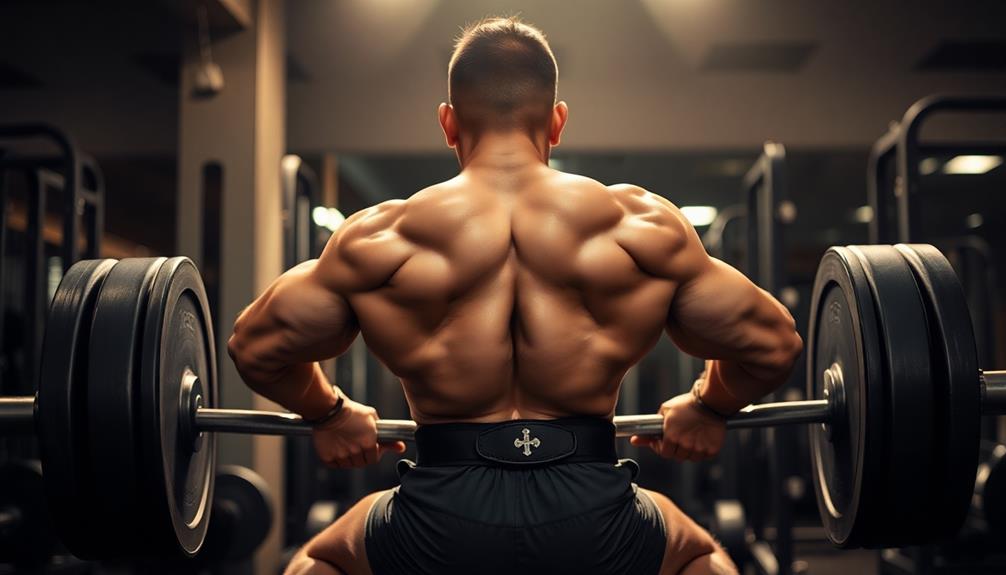
Compound movements are the key to building muscle through powerlifting. These exercises work several muscles at once, giving you the most muscle growth. While you can use kettlebells for strength training, powerlifting usually involves barbells. The main compound lifts in powerlifting are squats, bench presses, and deadlifts.
Squats work your legs, core, and back, helping you build up your lower body. Bench presses target your chest, shoulders, and triceps, making your upper body stronger. Deadlifts engage your whole posterior chain, from your calves to your traps, activating your entire body.
Hormonal Response to Heavy Lifting

Heavy lifting triggers your body to release special hormones that help build muscle and strength. These hormones include:
- Testosterone: Helps your muscles grow
- Growth hormone: Repairs tissue and burns fat
- IGF-1: Makes muscle cells multiply
- Cortisol: Controls metabolism and recovery
When you lift heavy weights, these hormones work together to create the perfect environment for building muscle and getting stronger. You'll notice a big increase in these hormones during and right after your heavy lifting workouts. To get the most out of this hormone boost, focus on heavy compound exercises and keep your rest periods short. Some athletes also take HMB supplements to potentially build more muscle, but it may not work for everyone. The key is to stay consistent – regular heavy lifting sessions will keep your hormone levels high, leading to better muscle growth over time.
Muscle Fiber Recruitment in Powerlifting

Powerlifting relies on using different types of muscle fibers. When you lift heavy weights, like in squats, deadlifts, and bench presses, you use both slow-twitch and fast-twitch muscle fibers. Slow-twitch fibers are used first and help with endurance and stability. As you add more weight, your body uses more fast-twitch fibers for explosive power and strength. Many powerlifters drink high-carb shakes after their workouts to help their muscles recover and refill energy stores.
Using all these muscle fibers leads to more muscle growth and strength gains. That's why powerlifting is so good for building muscle. The high-intensity lifts make your body adapt by growing bigger and stronger muscles. As you keep lifting, you'll see improvements in your power and muscle size. Just remember to use proper form and gradually increase the weight to get the most benefit and avoid injury.
Recovery and Muscle Hypertrophy

After tough powerlifting workouts, taking time to recover is key for building muscle. Your body must repair to come back stronger. To maximize gains, focus on:
- Getting 7-9 hours of sleep each night
- Eating right, with plenty of protein
- Drinking enough water
- Light activities like stretching or easy cardio
Post-workout smoothie packs are a great way to jump-start recovery. They offer a fast, simple protein source and other important nutrients.
During rest, your muscles respond to the challenges of lifting by growing bigger and stronger. This process is called hypertrophy. It happens when your body builds more muscle than it breaks down. To support this, eat a little extra and get enough protein – about 1.6 to 2.2 grams for every kilogram you weigh. Keep in mind, muscles don't grow during workouts. Growth happens as you rest and recover. Make recovery a top priority, right alongside your gym time, for the best results.
Nutrition for Powerlifting Muscle Gains

Eating right is crucial for making gains in powerlifting. First, figure out how many calories you need each day, and aim for a little extra to help build muscle. Choose high-quality protein sources like lean meats, fish, eggs, and dairy to give your muscles the amino acids they need to repair and grow.
Carbs are also important for energy during tough lifting sessions. Go for complex carbs like whole grains, sweet potatoes, and oats. Include healthy fats from foods like avocados, nuts, and olive oil to support your hormones. You can also use carbohydrate powders after your workouts to refill your glycogen stores and help your muscles recover.
Timing matters: eat a meal with protein and carbs before and after your workouts. Drink plenty of water throughout the day, and think about taking creatine monohydrate to boost your strength and muscle gains. Remember, sticking to your nutrition plan is just as important as your training routine.
Periodization in Powerlifting Programs
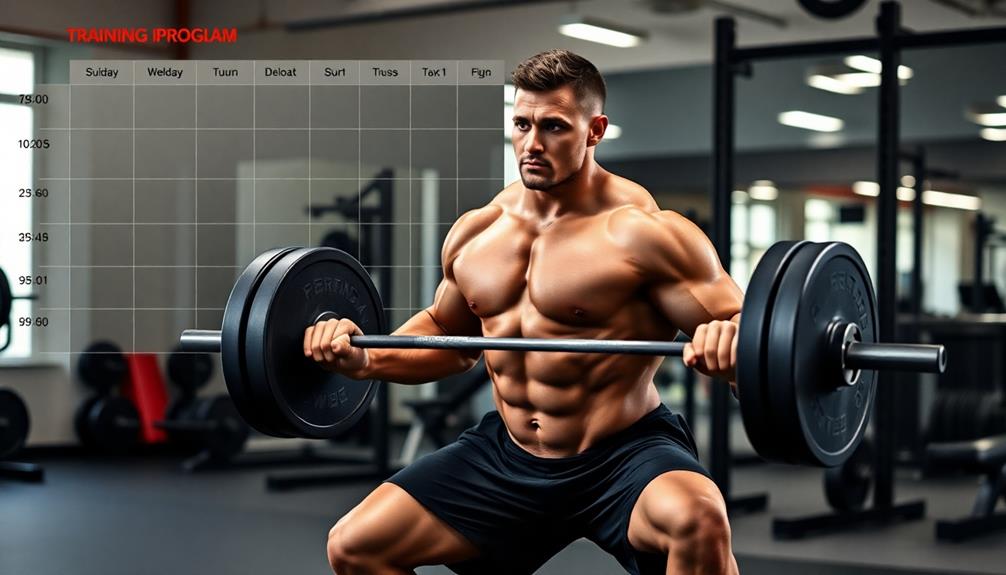
Powerlifters looking to get stronger should use periodization in their training. This means changing your workout routine over time to avoid plateaus and maximize performance. Periodization for powerlifting usually involves:
- Linear progression: Slowly increasing weight and lowering reps
- Undulating periodization: Switching between heavy and light training days
- Block periodization: Working on specific goals in different training phases
- Conjugate method: Changing exercises to train different types of strength
Supplementary Exercises for Muscle Building
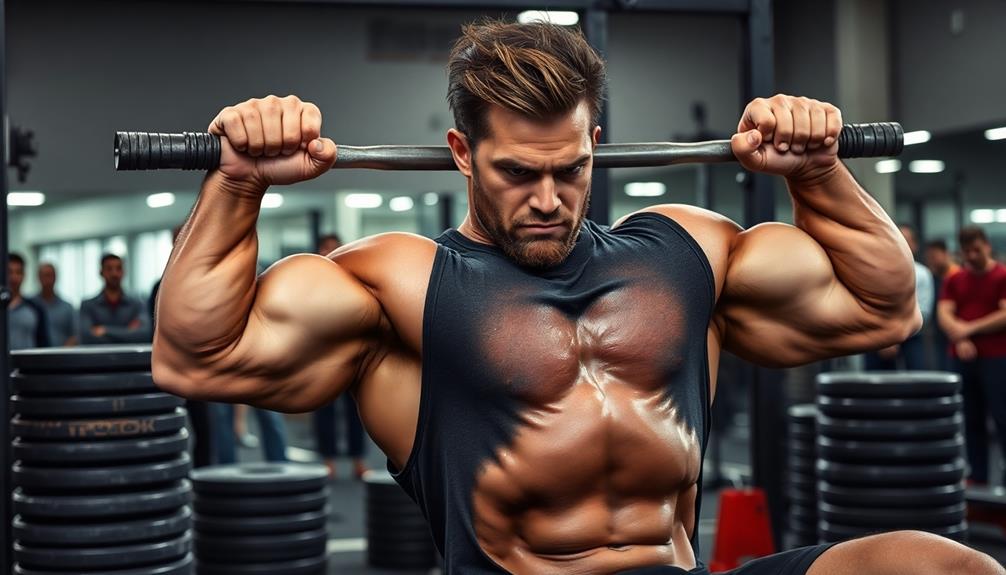
Supplementary exercises are crucial for building muscle and boosting your strength on the main powerlifting lifts. They target specific muscles and fix weak points that could be slowing you down. Check out this handy chart to see which extra exercises will help you the most:
Squat → Front Squats, Leg Press
Bench Press → Incline Press, Dips
Deadlift → Romanian Deadlifts, Good Mornings
All Lifts → Pull-ups, Rows
Mix these moves into your normal workout plan to pack on muscle and get better at squats, bench, and deadlifts. Just make sure to change the sets, reps, and weight based on where you're at in your training and how well you're recovering.
Mind-Muscle Connection in Powerlifting
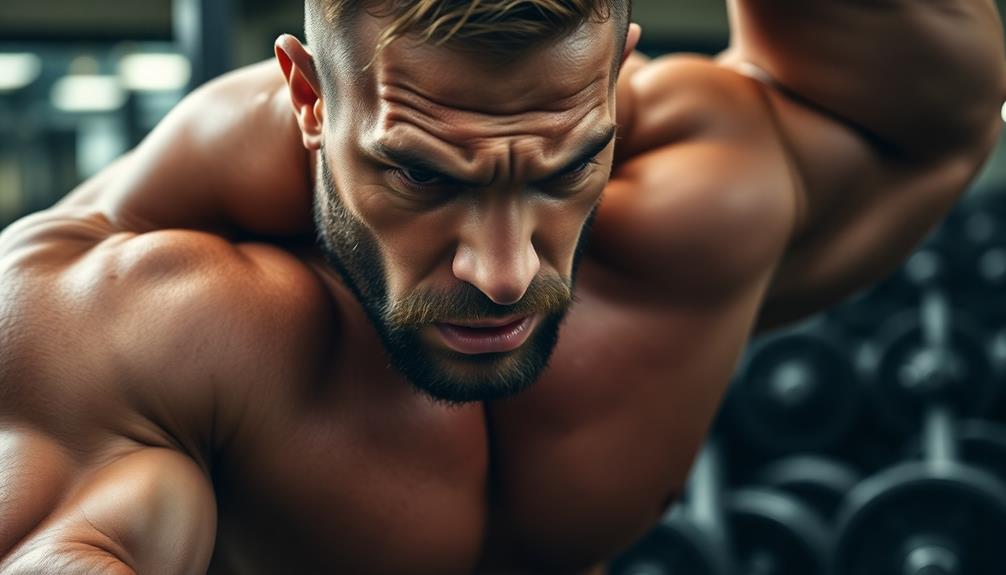
Strengthening your mind-muscle connection can really boost your powerlifting performance. It's all about focusing your mind on the exact muscles you're using for each lift. It's kind of like how compression sleeves target specific areas to help you lift better. Mind-muscle connection lets you zero in mentally on the muscles you're working. Here are some ways to boost your mind-muscle connection:
- Picture your muscle squeezing as you do each rep
- Go slower with controlled motion to really feel the muscle at work
- Start with lighter weights so you can focus on good form and feeling the movement
- Hold the weight still at times to increase muscle awareness
Frequently Asked Questions
How Long Does It Take to See Noticeable Muscle Gains From Powerlifting?
You'll typically notice muscle gains from powerlifting within 4-8 weeks. However, visible results vary based on your diet, training intensity, and genetics. Consistency is key, so stick to your program and you'll see improvements over time.
Can Powerlifting Be Combined With Other Forms of Training for Muscle Growth?
Yes, you can combine powerlifting with other training forms for muscle growth. You'll benefit from incorporating hypertrophy-focused exercises, bodyweight movements, and cardio. This balanced approach enhances overall muscle development and complements your powerlifting strength gains effectively.
Is Powerlifting Suitable for Women Looking to Build Muscle Mass?
Yes, powerlifting is suitable for women looking to build muscle mass. You'll benefit from its focus on compound movements, which stimulate overall muscle growth. It's an effective way to increase strength and build lean muscle tissue.
What's the Ideal Training Frequency for Muscle Growth Through Powerlifting?
You'll typically see the best muscle growth with 2-4 powerlifting sessions per week. Aim for 3-4 sets of 6-8 reps per exercise. Don't forget to allow for adequate rest between workouts to maximize gains.
How Does Age Affect Muscle-Building Potential in Powerlifting?
As you age, your muscle-building potential decreases due to hormonal changes and slower recovery. However, you can still make significant gains in powerlifting. You'll need to focus on proper nutrition, adequate rest, and consistent training to maximize results.

